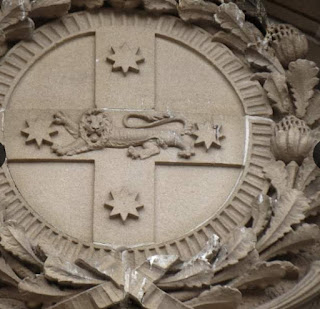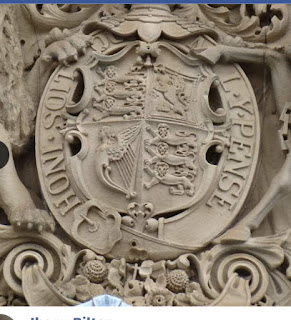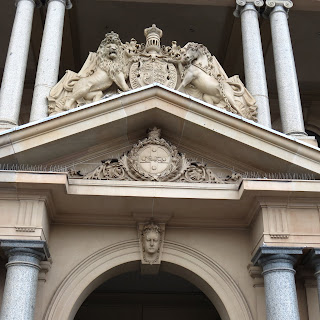Search This Blog
Monday, March 15, 2021
Foundation Of Australia - Loftus Street, Eastern Side - Near Circular Quay
Tuesday, March 3, 2020
Customs House Lane - Circular Quay - Sydney - New South Wales
Customs House Lane - Circular Quay - Sydney - NSW
Hinchcliffs Woolstore, On The South West Corner, Built 1860 - 1880, Is A Rare Survivor From The Time When Circular Quay Was A Centre For International Shipping & Wool Was Australia's Greatest Export. Imagine The Bales Being Raised On The Hoist Pulleys That Are Still Attached To The Building. In The Second Half Of The 20th Century The Building Was Set Up With Dormitories & A Soup Kitchen And Used As The Matthew Talbot Hostel For Unemployed Men.
Customs house was where shipping was cleared and goods passing through the Port of Sydney will text for sale or export.
When the port was busy the house was crowded and noisy, a scene of raised tempers, delays in disputed dealings.
The six story colonnaded building you see today evolve through several phases of expansion between 1845 and 1917.
On Loftus Street alongside the house, union Jack flies permanently on the site where the first British flag was raised.
Thursday, December 8, 2016
Customs House - 31 Alfred Street - Circular Quay - Sydney Cove - New South Wales
Customs House
Built - 1844 - 1845
Architect - Mortimer Lewis - Colonial Architect
Additional Architects -
1887 - James Barnet - Colonial Architect
1896 - Walter Liberty Vernon - Government Architect
1915 - George Oakeshott
Sydney's Custom House At Circular Quay Occupies A Unique Symbolic Place On The Site Of The Foirst Fleet Landing In 1788. Today Its Location Is A Physical Reminder Of The Importance Of Circular Quay As The Original Maritime Centre Of The Colony, And The Colony's reliance On Trade. Its Renewal Over The Decades Also Emobides The Work Of Three Government Architects
The Customs Service ws Responsible For All Imports And Exports, Excise On Local Goods, Immigration Control, And Control Of Narcotic Substances And Morally Corrupt Goods (Such As Books And Films)
By 1844, With Sydney's Maritime Trade Booming, The Existing Customs Building In The Rocks Was Packed To The Rafters. This Prompted Governor Sir George Gipps To Commission A New 2 Storey Georgian Building, Designed By Colonial Architect Mortimer Lewis, With A Facade That Included 13 Large Windows Offering Commanding Views of Shipping Activity In Sydney Cove.
In 1887, The Building Was Partly Dismantled And Expanded To Three Levels By Colonial Architect James Barnet. It was Further Expanded In 1896 By Government Architect Walter Liberty Vernon, Who Staged Alterations Adding Two New Levels And A Rear Wing In The Courtyard. In 1915, Architect George Oakeshott Add A New Framed Internal Structure That Opened Up The Ground Floor With An Atrium.
Despite These Later Additions During World War 1, Significant Parts Of The Original Building Remain Today, Having Been In Continuous Use For 145 Years As Headquarters For The Customs House Right Up Until 1990. in 2003 The Historic Building Became The Venue For The City Of Sydney Library, Along With restaurants, Bars And Offices.
There Is A Scale Model Of Sydney's CBD, Under A Glass Floor In The Ground Floor Foyer. At A Scale Of 1:500, It Covers Around 10 Square Kilometres Of The City And Includes More Than 1000 Detailed Buildings, As Well As 5000 Trees, And People, And Cars And Boats
The 6 Storey Building Evolved through Several Phases Of Expansion Between 1845 & 1917.
On Loftus Street Alongside Customs House, A Union Jack Flies Permanantly On The Site Where The British Flag Was First Raised On January 26th 1788. For Some Australians, This Is The Site Of The Invasion.
Customs House in Sydney, Australia, is an iconic heritage building that has played a significant role in the city's history. It has served various functions over the years and stands as a symbol of maritime trade, cultural engagement, and architectural beauty. Here's a comprehensive overview of its history:
Early History:
- The original Customs House on the site was constructed in the early 19th century. It served as a customs and maritime office to regulate trade and collect taxes on imports and exports.
Construction of the Current Building:
- The present-day Customs House building was constructed between 1844 and 1845, designed by colonial architect Mortimer Lewis in the Neoclassical architectural style.
- The building's design features grand columns, a pediment, and ornate detailing, reflecting the architectural trends of the time.
Function as Customs Office:
- The new Customs House continued to serve as a hub for customs and maritime operations, facilitating trade and overseeing shipping activities in Sydney Harbour.
Expansions and Additions:
- Over the years, Customs House underwent expansions and additions to accommodate its growing functions and staff.
- In the late 19th century, additional wings were added to the building to accommodate increased maritime activity.
Cultural Role and Transformation:
- In the 20th century, as shipping and customs operations moved to other locations, Customs House underwent a transformation into a cultural and public space.
- In 1988, the building was renovated and repurposed as a multi-purpose cultural and educational center.
City of Sydney Library:
- Customs House houses the City of Sydney Library, offering a range of books, resources, and services to the public.
- The library features modern amenities while preserving the building's historical features.
The Sydney Room:
- The Sydney Room within Customs House holds a collection of historical maps, plans, photographs, and documents related to the city's history.
Civic and Cultural Events:
- Customs House is also used as a venue for various civic and cultural events, exhibitions, and lectures.
Lighting of the Dome:
- The dome of Customs House is often lit up with colorful and dynamic light displays to mark special occasions, events, and celebrations.
Heritage Status:
- Customs House is recognized as a heritage-listed building, reflecting its historical, architectural, and cultural significance.
Customs House stands as a reminder of Sydney's maritime heritage and its transition from a functional government building to a dynamic cultural center. Its architectural beauty, versatile functions, and central location have made it a focal point of Sydney's urban landscape and cultural life


















































